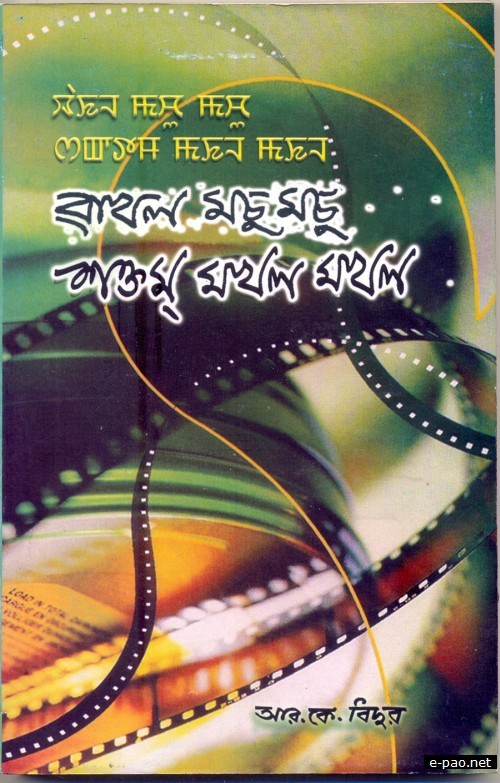'Wakhal Machu-Machu, Shaktam Makhal-Makhal' :: Book by R.K. Bidur
Review by Longjam Joychandra Singh *

Book cover of Wakhal Machu-Machu, Shaktam Makhal-Makhal
1. Name of the Author : R.K. Bidur
2. Tittle of the Book : 'WAKHAL MACHU-MACHU, SHAKTAM MAKHAL-MAKHAL' (Array of Colourful Thoughts, Medley of Images)
3. Review by : Longjam Joychandra Singh
4. Publisher : RK (O) Jibanmala Devi, for Tonsija Publicasions, Nongmeibung Leikai, Imphal
Price : 300.00
The book is a unique anthology of writings on film in Manipuri; the author is an eminent film critic and winner-Best Critic Awards with Swarna Kamal, 56th National Film Awards, 2008. Being penned by a person who has wide exposition and experience to the world of film in general and Manipuri film in particular, the articles featured in the book are worth reading and thought provoking. The book is not only for consumption of the armchair scholars but also an excellent informative book for readers who desire to traverse both the known and the unknown world of film, specially at the grass root level. As such it offers a rare account of film on various subjects, presented in simple, lucid style yet highly charged with academic precision hitherto unknown in Manipuri film writing.
The book, running into 246 pages is divided into two sections. The first contains 31 articles covering the wide spectrum of Manipuri film like the development of film society movement, film journalism, appreciation, criticism at large. The writer takes pains in describing internationally reputed film director, Aribam Syam Sharma's three works - 'Imagee Ningthem' (My Son, My Precious, 1981),' Ishanou' (The Chosen One, 1991) and 'Sanabi' (The Grey Mare, 1995) as first trilogy of Manipuri Cinema.
He writes, the trilogy just catapulted Aribam Syam Sharma to the zenith of his fame. Apu, son of the poor Brahmin, Harihar Roy of Nishchindipur village is the character around which the Apu Trilogy of Satyajit Ray is woven; however there is no such individual character in Aribam's Trilogy. On the other hand it is Manipuri woman that serves as central figure in all his three films.
RK Bidur recounts the details of embryonic contribution of pioneer film persons to the growth of Manipuri Cinema vis-a vis the world cinema movement spearheaded by genius like Ingmar Bergman, Michelangelo Antonioni, Akira Kurosowa etc. There are articles also giving critical assessment of film seminars and workshops at the local, regional and national levels. Articles on various personalities like film maker Syam Sharma, theatre icon Ratan Thiyam, Prof. E. Nilakanta, and 'Iron Lady' Sharmila Chanu, winner 'Gwangzu Prize' for Human Rights, 2007 (Korea) relating to their contributions to Manipuri film and the filming on themselves offer tasteful reading, the author highlights his resourceful experiences of participation at various film festivals-including International Film Festival of India (IFFI) at both New Delhi and Goa, conferences and discussions held at the local and national arena.
He laments that inspite of the good work done by the Government for the development of film in Manipur, lack of proper planning and capital resources to preserve Manipuri films by instituting Manipuri Film Archive present yet another dismay for Manipuri film lovers. Miles have been achieved yet there are miles to go for Manipuri films, the author concludes in his depth analysis. He makes a remarkable evaluation of the invention of Lumiere brothers- Luis and Auguste's. "Cinematographe" and says that though magic of Lumiere brothers' invention had lost its charm and became obsolete by the advent of 20th century, it surely bestowed a basic lesson of the medium to the future generation.
The Second Section contains 15 articles on Rabindra Nath Tagore, M.F. Hussain, Kaifi Azmi, Chidananda Das Gupta, Bismilah Khan and film doyens like Ingmar Bergman, Elizabeth Taylor, Tony Curtis, Charlton Heston, Sir Alec Guinness, Laurel and Hardy. It is a fitting tribute to their lives and works.
To most people Tagore is a known figure of literature, music, dance and painting. However in the book RK Bidur makes an outstanding revealation of Tagore's yet another talent of being able to understand film medium and doing various film activities after seeing Lumiere brothers' Cinema in 1896. Tagore wrote a letter expressing his opinion about the new medium to Murali Manohar, younger brother of noted film maker Sisir Kumar Bhaduri on Nov. 29, 1896- "I believe that the expected emergence of cinema as an art form is yet to take place... the beauty and the grandeur of this form in motion has to be developed in such a way that it became self sufficient without the use of words. If some language is needed to explain its own, it amounts to incompetence."
Gurudev Rabindranath Tagore made an extensive tour of Europe, Russia and America and wherever he had been, he first visited film studios and talked to artistes and technicians on various potential quality of cinema. On return from the travel he helped a lot of film makers in filmming his stories and he even wrote film scripts.
A special mention may be made of an article on famous lyricist and 'Shayar' - Kaifi Azmi; some filmic songs and 'Shairs' of Azmi are translated in the vernicular and explained the meanings beautifully in a way that makes it easy to understand and every reader will surely like them. It may not be out of place to mention that RK Bidur Singh the author, though belongs to a Non Hindi speaking state, has a profound knowledge of Urudu and Hindi, he loves 'Shairs', 'Ghazals' too.
Another feature he writes with certain interest and information is about "Sang-e- Mulakat" (Meeting with the Mile Stone) a 35 mm, 90 mnts, color documentary on shehnai Maestro, Bismillah Khan. The project of making his documentary was assigned to the noted film maker of Bengal-Goutam Ghose by the National Film Development Corporation in 1989. RK Bidur himself enjoyed the screening of this documentary film at the Inox Screening -4 on the occasion of the International Film Festival of India 2006, Goa. The author informs us that it was not exactly biographical yet many splendiferous moments of the life of the Maestro are well documented. Bismillah Khan was interviewed by A.N. Rasid Khan, a retired I.P.S. Officer and the conversations give us a lot of interesting information that one did not know earlier about Bismillah Khan.
His writings on film doyens like Ingmar Bergman, Elizabeth Taylor, Tony Curtis, Charlton Heston, Sir Alec Guinness, Laurel and Hardy make an interesting and informative reading matter. Though appeared in many genre-films, Alec Guinness's role and excellent performance in "The Bridge On the River Kwai" (1957) won him Best Actor Academy Award. In 1959 he was knighted by Queen Elizabeth for his marvelous achievements on stage and screen. RK Bidur's article "Who is Afraid of 'Liz' Taylor" contains some exciting and superb accounts of Liz's life. In the opinion of many she was considered "the most beautiful woman and one of the most popular screen personalities of all times." Asked about her frequent marriages and divorces, pat came reply from her "I don't know, honey. It sure beats the hell out of me." In 1949, "TIME" Magazine called her "jewel of great price, a true star sapphire." And she won the Academy Award twice. The author vividly recalls the challenging roles and superb performances by Charlton Heston and Tony Curtis in films he'd seen at the local theatres long time back. A nice recall!
His extensive coverage on Laurel and Hardy is all the more interesting. The most successful comedy team in the history of the screen, a skinny-fatty duo, appearing together in numerous silent and sound short and feature films brought laughter to millions of viewers all over the world. The memory of Laurel and Hardy has been kept alive by T.V. shows and successful compilation of films highlighting their work.
The author quotes a writing from the epitaph-
"Two epoch making Comedians
Stan Laurel and Oliver Hardy
Who are no more today
'Cause Death wished
To have their Comedies
In His Silent Realm."
To add additional information to the list of illustrious persons, a few articles are devoted to indigenous film makers and personalities like S.N. Chand, M.K. Binodini, K. Ibohal Sharma and the noted Manipuri film music director, singer Aheibam Shyam.
The book on the whole, is a store house of knowledge on films for both indigenous and non-indigenous readers. It is a rare feat in a place like Manipur which always suffers for good writings in spite of its great names for performing arts like dance, music and theatre. Manipuri films however, in recent years have crossed its indigenous boundary to reach not only to national capital but also other film cities of the country and the world with its unique look and style.
The author, while acutely sensing this emerging trend of Manipuri film has recorded beautifully the world of Manipuri film vis-a-vis the great trend of world cinema.
It is a book on film with a difference.
